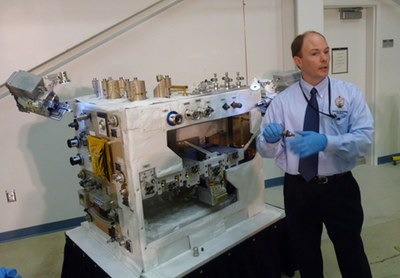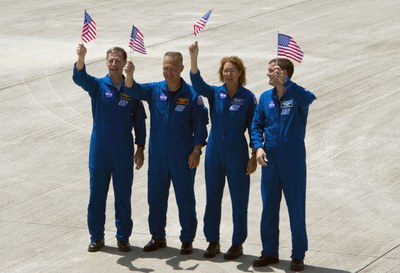The mission of the final shuttle missionby Jeff Foust
|
| “This was a flight that we were not sure as late as this January that we were going to have the opportunity to fly,” said Shannon. |
So far, that coverage has focused on the end of the shuttle program and the uncertain future for NASA’s overall human spaceflight program, with varying degrees of sensationalism and hyperbole: the cover story of the latest issue of the British newsweekly The Economist, for example, shows a shuttle silhouetted against an orbital sunset, with the caption: “The end of the Space Age”. Yet, there’s far less attention devoted to the mission itself. Watching much of the media coverage, one might be left with the impression that the flight is little more than a victory lap for the shuttle program. Instead, STS-135 is carrying out a key mission to help support the continued operations of the International Space Station (ISS) and testing technology that can support satellite servicing.
Stocking up the station
STS-135 is a late—and final—addition to the shuttle manifest. The hardware for the mission beyond the orbiter itself—the external tanks and solid rocket booster—were originally intended for the “launch on need” rescue mission for STS-134, the previous final shuttle mission, should it experience problems in orbit that would require a rescue mission. (STS-134 was itself a mission tacked on to the shuttle manifest in 2009 in order to fly the Alpha Magnetic Spectrometer experiment.) Last year there was some discussion in Congress about turning the launch on need hardware into an additional shuttle mission, in part to extend the shuttle program and close the gap between the shuttle and its successor system—at that time still the subject of debate—and the additional mission was included in the NASA authorization act signed into law last October.
However, as recently as early this year NASA was still trying to figure out to squeeze that final mission into the agency’s constrained budget. “This was a flight that we were not sure as late as this January that we were going to have the opportunity to fly,” said Space Shuttle program manager John Shannon in a media briefing last week. Concerns about the shuttle’s external tank, along with the need to focus on the two missions ahead of STS-135 and uncertain funding, weighed on the program. Those concerns were overcome, he said, “and here we are, ready to go.”
The primary purpose for the STS-135 mission is to deliver additional supplies to the ISS. In Atlantis’s cargo bay is the Raffaello Multi-Purpose Logistics Module (MPLM), which contains over 3,900 kilograms of supplies that will be transferred to the station during the mission. Raffaello will also be loaded with unneeded items from the station for return to Earth on Atlantis.
Those supplies are designed to keep the station in normal operations for the next year, by which time NASA hopes that its two commercial cargo providers, Orbital Sciences Corporation and SpaceX, will be ready to carry cargo to the ISS. In essence, this mission gives those companies—and by extension NASA—some breathing room to get the post-shuttle supply chain up and running without impacting ISS operations.
“Some folks look at this flight and don’t perhaps see the excitement because we don’t have a piece of major assembly hardware going up,” said ISS program manager Mike Suffredini at the same briefing. However, he said the supplies being carried up to the station are essential to its long-term future. “While it doesn’t look very sexy, it’s one of the most important flights that we’ve ever had come to ISS from a shuttle perspective.”
Suffredini said the additional supplies would allow NASA to continue normal station operations at least until mid-2012, at which time he said the agency would revisit the situation should neither company have its cargo transportation system up and running. He was confident, though, that it wouldn’t be a problem. “I think they’ll be fine,” he said of Orbital and SpaceX. “I expect to see them in late fall or early next year, and that will be plenty of time to keep the logistics train going.”
One official noted that the final flight of the shuttle will perform a mission that had been part of the original vision for the program. “It’s quite fitting that the final flight of the shuttle is exactly the type of mission that its designers originally intended, and that is to service a manned laboratory in low Earth orbit,” said lead ISS flight director Chris Edelen at a briefing last week.
 Deputy project manager Ben Reed stands by a replica of the Robotic Refueling Mission that will be flown to the ISS on STS-135. (credit: J. Foust) |
Testing robotic servicing technology
Atlantis, though, is carrying more than just mundane supplies for the station’s crew. Included in the cargo bay is an experiment called the Robotic Refueling Mission (RRM). A box about one meter on a side, spacewalkers will move the RRM to a temporary location on the station during the STS-135 mission; later, the station’s robotic arm will transport the RRM to its permanent location, ExPRESS Logistics Carrier 4 (ELC-4), on the station’s truss.
| “We don’t want to be in the business of refueling satellites,” Reed said. “NASA wants to develop the technology, pass it on to industry, and go on and develop different technologies.” |
The purpose of the RRM is to test technologies that could allow future robotic spacecraft to service and refuel satellites. The RRM contains several tools developed at NASA Goddard Space Flight Center that can be used by the Dextre robotic manipulator on the ISS. The outside of the RRM is studded with a variety of different valves, caps, and other items like those found on satellites. Ground controllers will use those tools to test removing caps, cutting wires, and eventually transferring propellant.
The challenge of satellite servicing is that spacecraft generally aren’t designed to be refueled after launch: once loaded with propellant the fueling valves are sealed up tightly to prevent leakage. “It’s not very simple,” said deputy project manager Ben Reed during a media event last week at NASA Goddard. “We want to be able to develop robotic technology to do these difficult tasks, and that’s what led us to design RRM.”
Once RRM is installed on ELC-4, in August, NASA will begin some initial experiments with the module. More thorough tests, though, will have to wait until a software patch for Dextre is uploaded to the station this fall. Project officials at Goddard said they hope to be able to start more complex experiments with the RRM in November or December.
The RRM has attracted some attention, even controversy, because of concerns that it might be competing with privately-developed technologies. Last month the Canadian newspaper The Globe and Mail reported that MacDonald Dettwiler and Associates (MDA), which has an agreement with satellite operator Intelsat to develop its own satellite servicing technology, feared that NASA would try to commercialize its own technology and undercut MDA. “We would have very challenging competition for the important U.S. government market” if NASA got involved, Steve Oldham, president of MDA’s satellite servicing business, told the paper.
At last week’s event at Goddard, project officials said there were in fact no plans to try and turn this technology demonstration into a commercial enterprise. “We don’t want to be in the business of refueling satellites,” Reed said. “NASA wants to develop the technology, pass it on to industry, and go on and develop different technologies.”
Project manager Frank Cepollina likened NASA’s investment in the RRM to its work a half-century ago on early communications satellites, work that was later transferred to the private sector. “We’re providing the encouragement [to the private sector] and letting them take it from there,” he said.
Staying focused
One challenge unique to this particular mission is staying focused on the task at hand—safely flying the mission—amid all the attention devoted to the end of the Space Shuttle era and the uncertainty that lies beyond. Both NASA and industry officials pledged their commitment to keeping their attention on a safe and successful STS-135 mission.
| “The prevailing sense, and the prevailing desire, is to fly this mission safely and successfully, because we think that is the most powerful legacy that we could leave for this program,” said lead flight director Alibaruho. |
“We’re poised to finish strong, and preserve the legacy of everyone who has been a part of the shuttle team,” Shannon said at last week’s briefing. “This team is not focused right now on ‘lasts’. I see a huge amount of determination to make sure this flight goes extremely well.”
“This team and the people here at Johnson Space Center have not been tremendously focused on this flight as ‘the last flight’,” said Kwatsi Alibaruho, lead shuttle flight director, at last week’s JSC briefing. “The prevailing sense, and the prevailing desire, is to fly this mission safely and successfully, because we think that is the most powerful legacy that we could leave for this program.”
That sense of commitment extends to industry as well. Jim Maser, president of Pratt & Whitney Rocketdyne, the company that provides the shuttle’s main engines, said in an interview last week that he has reminded his employees to be focused on a successful last mission despite the uncertainty of what NASA will do with the Space Launch System in particular, the heavy-lift rocket that may or may not incorporate engines developed by his company.
“We do have a team of dedicated professionals and they have a laser-like focus on what we’re doing” for the final shuttle mission, he said. “The single most important thing for securing our future is to execute on the current business we have today.”
So as analyses of the shuttle program’s history and legacy, and the future of NASA human spaceflight, pile up in the days and weeks to come, remember that it’s not over until Atlantis rolls to a stop on the runway later this month, its final mission finally complete.
